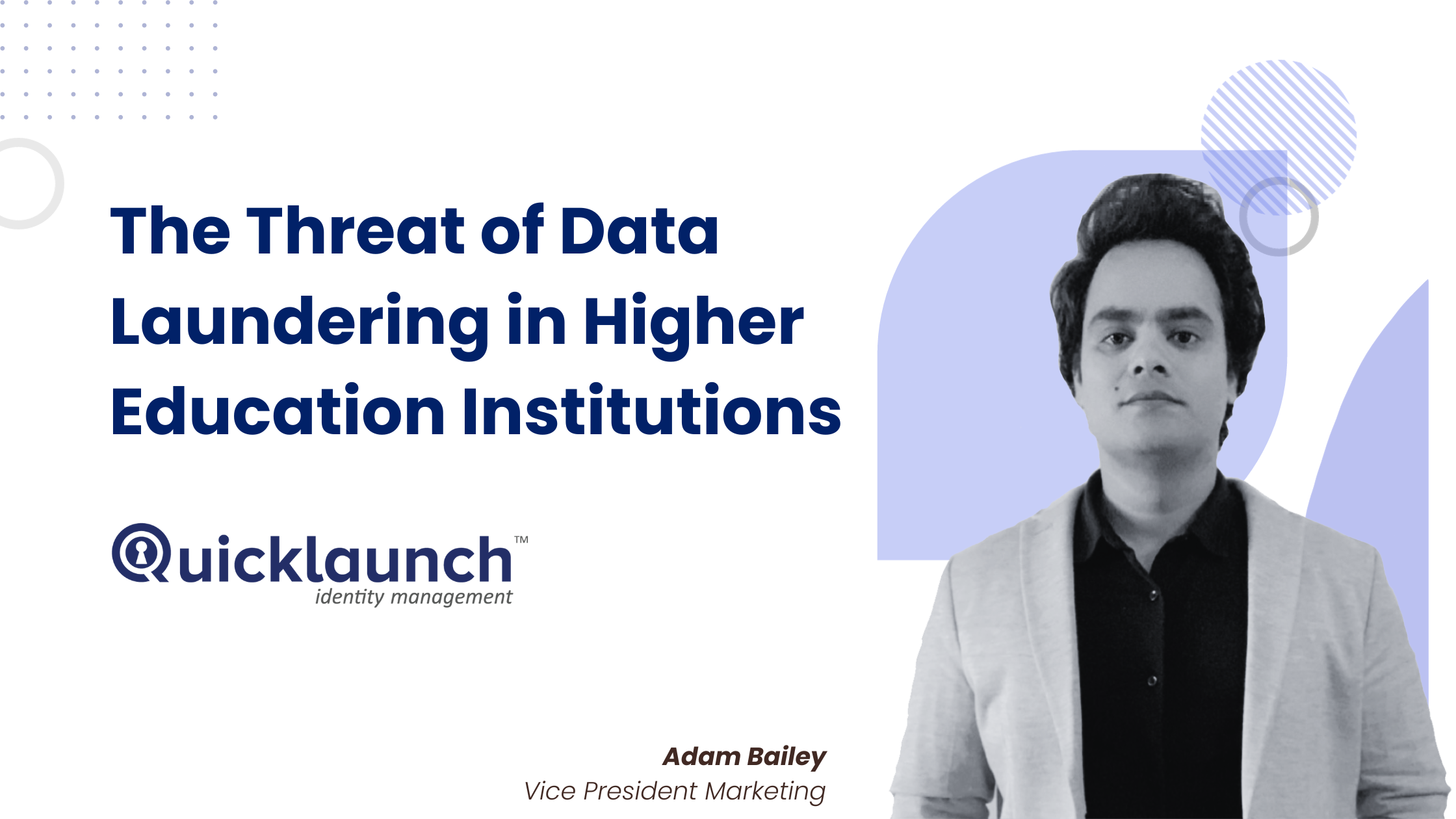The Threat of Data Laundering in Higher Education Institutions

QuickLaunch: Celebrating 5 Years of Innovation, Progress, and Empowering Identities
February 8, 2024
Guiding CTOs Through Shadows: Exposing Password Vulnerabilities in Higher Education
March 3, 2024
In an increasingly data-driven world, higher education institutions are not immune to the risks associated with data security. While data breaches and cyberattacks often make headlines, there is a lesser known yet significant threat lurking in the shadows: data laundering. This blog delves into the concept of data laundering and its implications for higher education institutions.
Understanding Data Laundering:
Data laundering is the process of manipulating or falsifying data to make it appear legitimate, trustworthy, or compliant while hiding its illicit origins or unauthorized modifications. It involves altering, fabricating, or obfuscating data to deceive and bypass security measures. In the context of higher education institutions, data laundering poses unique challenges and risks.
Data Laundering Facts by Gartner and Forrester:
- According to Gartner, by 2023, organizations that fail to control data quality effectively will experience a 65% increase in the financial impact of data quality issues, including data laundering attempts.
- Forrester states that data governance and data quality programs are crucial for preventing data laundering, and organizations that invest in these programs can reduce the risk of data breaches by up to 70%.
- Gartner predicts that by 2025, more than 50% of organizations will have implemented proactive data lineage tools to detect data laundering and ensure data integrity.
Implications for Higher Education Institutions:
1. Admission Fraud: Data laundering can occur during the admission process, where applicants might forge documents, transcripts, or test scores to gain admission. Institutions that fail to detect such fraudulent activities risk admitting unqualified individuals, compromising the integrity of the admissions process.
2. Research Misconduct: Data laundering can also affect the credibility of research conducted within higher education institutions. Dishonest researchers might manipulate or fabricate research data to present false findings, compromising the reputation of the institution and the integrity of academic research.
3. Grant Mismanagement: Higher education institutions often receive grants and funding for research projects. Data laundering can lead to mismanagement of grant funds, as dishonest individuals may alter or misrepresent financial and research data to secure additional funding or divert resources for personal gain.
4. Student Records and Privacy: Student data, including personal information, academic records, and financial details, are valuable targets for data launderers. Breaches or unauthorized modifications to student records can lead to identity theft, academic fraud, or financial exploitation.
Preventing and Combating Data Laundering:
1. Robust Data Governance: Establishing strong data governance practices is crucial. This includes implementing comprehensive data policies, regular data audits, and strict access controls to ensure the integrity and authenticity of data.
2. Education and Awareness: Higher education institutions must educate their staff, students, and stakeholders about the risks of data laundering. Awareness campaigns, training sessions, and workshops can help foster a culture of data integrity and security.
3. Data Security Measures: Implementing robust cybersecurity measures, including network monitoring, encryption, multi-factor authentication, and intrusion detection systems, can fortify defenses against data laundering attempts.
4. Data Validation and Verification: Instituting rigorous data validation and verification processes can help detect discrepancies and anomalies in data sets. Regular audits and cross-checking data with reliable sources can mitigate the risk of data laundering.
Data laundering poses a significant threat to the integrity and security of higher education institutions. However, there are effective solutions available to combat this covert menace. QuickLaunch is one such solution, a comprehensive Identity and Access Management (IAM) platform that specializes in higher education.
QuickLaunch offers a powerful arsenal of security features, including robust multi-factor authentication (MFA). By implementing MFA, higher education institutions can strengthen their authentication processes and ensure that only authorized individuals can access sensitive data and resources. MFA adds an extra layer of protection, reducing the risk of data laundering attempts by making it extremely difficult for unauthorized individuals to gain access.
With QuickLaunch's MFA, higher education institutions can leverage a variety of authentication factors such as passwordless, biometrics, Google Auth, YubiKey, or OTPs to verify user identities. This significantly reduces the chances of data breaches, fraudulent admissions, and research misconduct. Additionally, QuickLaunch's advanced analytics and monitoring capabilities provide real-time insights into user activity, helping to detect and prevent any suspicious or unauthorized access attempts.
In all, QuickLaunch offers a robust solution to combat data laundering in higher education institutions through its powerful multi-factor authentication capabilities. By implementing QuickLaunch's IAM platform, institutions can enhance data security, protect student records, uphold research integrity, and maintain regulatory compliance.
Schedule a Free Demo:Discover how QuickLaunch can help your higher education institution safeguard against data laundering threats. Schedule a free demo today and see firsthand how QuickLaunch's multi-factor authentication and comprehensive IAM platform can fortify your institution's data security.
Schedule a free demo with QuickLaunch to protect your institution from data laundering




